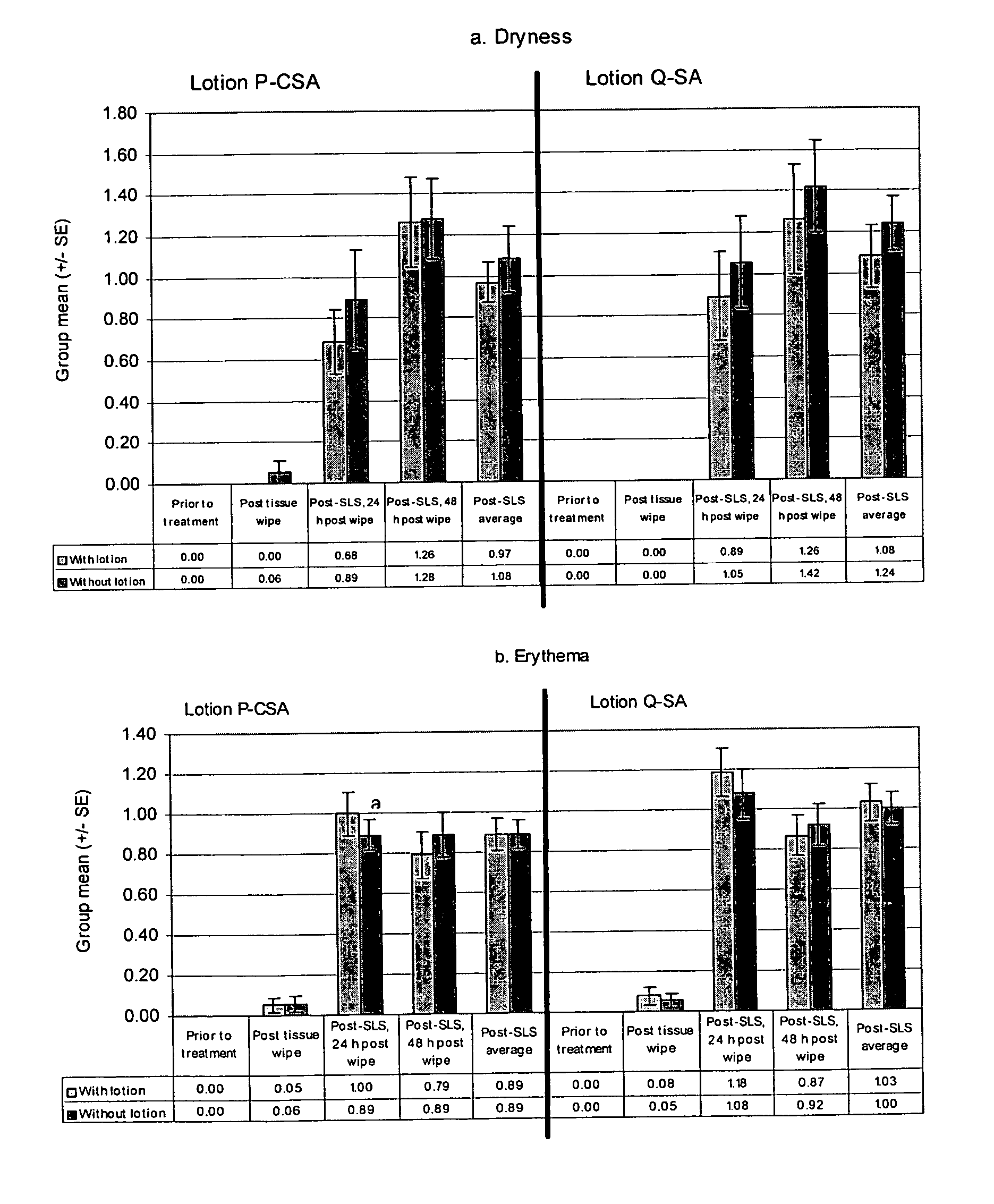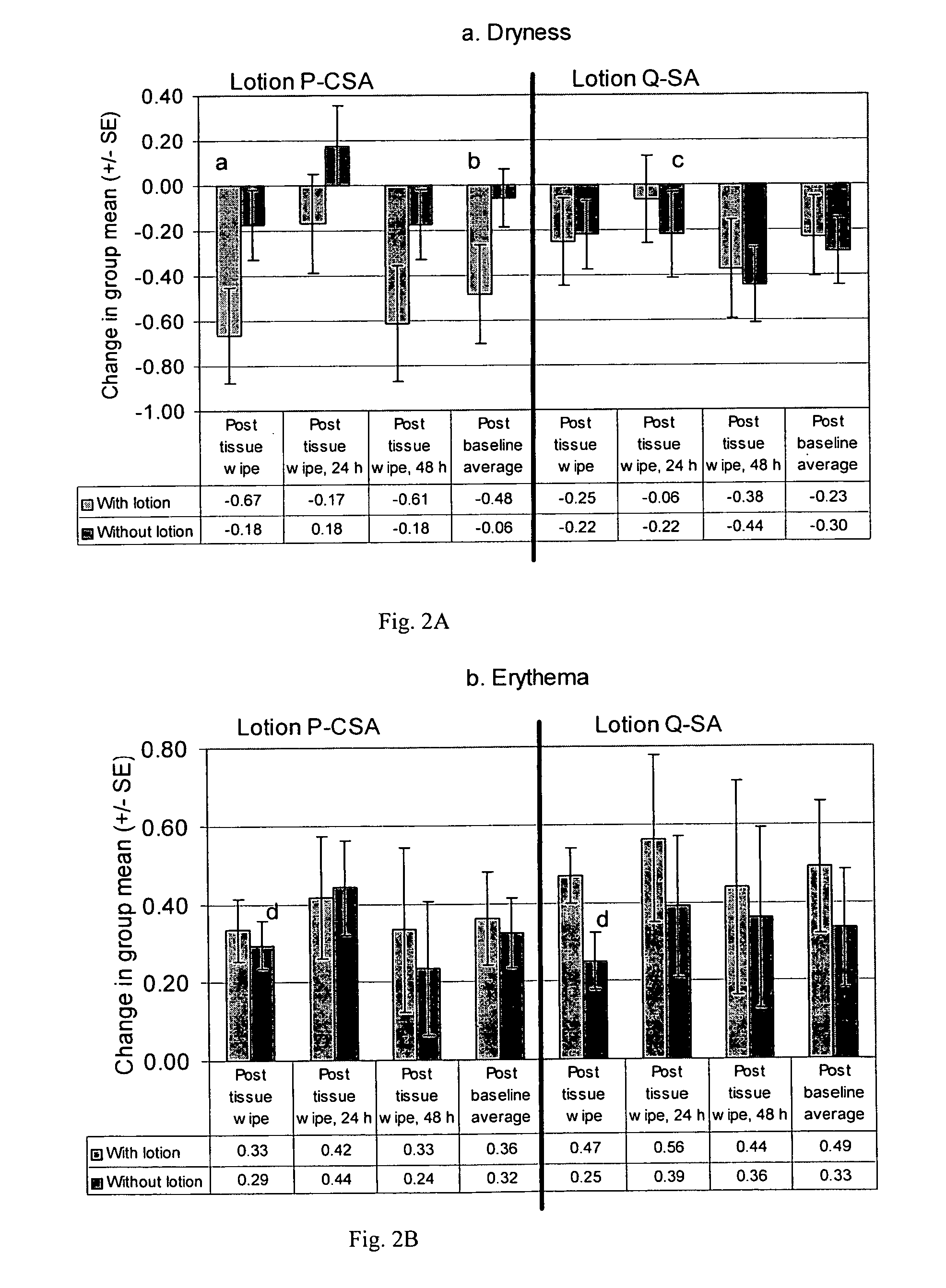Test method for assessing irritation of skin
a skin irritation and test method technology, applied in the field of testing methods for skin irritation, can solve the problems of not being able to meet the needs of cold and allergy sufferers, and none of the existing prior art test methods are suitable for assessing skin irritation of cold sufferers, so as to reduce such irritation and assess inhibition
- Summary
- Abstract
- Description
- Claims
- Application Information
AI Technical Summary
Benefits of technology
Problems solved by technology
Method used
Image
Examples
example 1
Facial Tissues Comprising Lotion
[0116]Test sites on the flexor surfaces of the forearms of 19 subjects (participants) were wiped with the lotion-containing samples (tissues) on day 1 using a total of 200 wipes (400 passes) in order to pretreat the portion of skin with lotion. This was followed by a 24-h occlusive patch with 0.25% SLS (sodium lauryl sulfate). Visual scoring of erythema and dryness was conducted. Scoring of the test sites was done prior to any treatment, immediately after the sample wipes (post sample wipes), 30 minutes after removal of the SLS patch (post-SLS patch, 24-h post wipe), and 24 hours after removal of the SLS patch (post-SLS patch, 48-h post wipe). The group mean scores (+ / −standard error) for dryness (a) and erythema (b) were determined for each scoring timepoint. Post-baseline average treatment comparisons were performed using analysis of variance (“ANOVA”). All other treatment comparisons were performed using the stratified Cochran Mantel Haenszel (“CMH...
example 2
Facial tissues comprising lotion
[0118]Test sites on the flexor surfaces of the forearms of 18 subjects were pretreated by 24-h patch with 0.25% SLS. After patch removal, test sites were wiped with the test samples (tissues) using a total of 200 wipes (400 passes). Visual scoring of erythema and dryness of the test sites was done prior to any treatment, 30 minutes after removal of the SLS patch, immediately after the sample wipes (post sample wipe), and at 24 and 48 hours after the sample wipes (post-sample wipe, 24-h, and post-sample wipe, 48-h). The change from post-SLS baseline was determined for each subject, then the average over all subjects was calculated. The post-baseline average was calculated using the average of all post-baseline visits for each subject, then calculating the average over all subjects. Treatment comparisons for erythema at 24-h, 48-h, and the change in post-baseline average were performed using ANOVA on ranks. For Sample 1, the concentration of lotion was ...
example 3
Facial Tissues Comprising Lotion
[0123]Test sites on the flexor surfaces of the forearms of 15–18 subjects were pretreated by 24-h patch with 0.25% SLS. After patch removal, test sites were wiped with the test samples using a total of 200 wipes (400 passes). Visual scoring of erythema and dryness of the test sites was done prior to any treatment, 30 minutes after removal of the SLS patch, immediately after the sample wipes, and at 24, 48 and 72 hours after the sample wipes. The change from post-SLS baseline was determined for each subject, then the average over all subjects was calculated. The post-baseline average was calculated using the average of all post-baseline visits for each subject, then calculating the average over all subjects. Erythema post-baseline average comparisons were performed using ANOVA. All other treatment comparisons were performed using ANOVA on ranks. For Sample 1, the concentration of lotion was 0.668 mg / cm2 and the concentration of lotion for Sample 2 was ...
PUM
 Login to View More
Login to View More Abstract
Description
Claims
Application Information
 Login to View More
Login to View More - R&D
- Intellectual Property
- Life Sciences
- Materials
- Tech Scout
- Unparalleled Data Quality
- Higher Quality Content
- 60% Fewer Hallucinations
Browse by: Latest US Patents, China's latest patents, Technical Efficacy Thesaurus, Application Domain, Technology Topic, Popular Technical Reports.
© 2025 PatSnap. All rights reserved.Legal|Privacy policy|Modern Slavery Act Transparency Statement|Sitemap|About US| Contact US: help@patsnap.com



